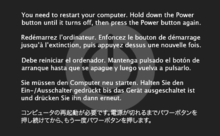Screen of death
In many computer operating systems, a special type of error message will display onscreen when the system has experienced a fatal error or is "bricked". Computer users have dubbed these messages screens of death as they typically result in unsaved work being lost and often indicate serious problems with the system's hardware or software. Screens of death are usually the result of a kernel panic, although the terms are frequently used interchangeably. Most screens of death are displayed on an even background color with a message advising the user to restart the computer.
Notable screens of death

The Mac OS X kernel panic alert. It can also be referred as a "black screen of death" as it is on top of a black background. This version was first used in Mac OS X 10.6.
- The Blue Screen of Death (also called BSoD, Stop error, or blue screen) is a common name for a screen displayed by the Microsoft Windows operating system when a system error occurs. Certain other systems and devices, including Android and the iPhone 5S, have also been known to display a blue screen in certain unexpected situations.
- A Black Screen of Death (also called BkSoD) is a failure mode of Microsoft Windows 3.x and also appears in iOS, showing only the Apple logo after everything goes black (this happens when the device freezes or is "bricked").
- A Red Screen of Death appears in early beta versions of Windows Vista (also appeared in some early build versions of Windows 98) and is also the colour of the fatal error screen on PlayStation consoles. The Kindle Fire shows a red screen when it is "bricked".
- The Purple Screen of Death is used by VMware ESX Server, a server virtualization product by VMware, Inc. It is displayed in the event of a fatal kernel error. The screen provides error codes that can be used for debugging purposes. It also appears on a DS when the cartridge is removed while playing the built-in application Pictochat.
- A kernel panic is used primarily by Unix and Unix-like operating systems: the Unix equivalent of Microsoft's Blue Screen of Death. It is used to describe a fatal error from which the operating system cannot recover.
- A Sad Mac is a symbol used by older-generation Apple Macintosh computers, starting with the original Macintosh 128K, to indicate a severe hardware or software problem that prevented startup from occurring successfully. A similar symbol exists for the iPod.
- The Bomb icon is a symbol that was displayed when a "classic" Macintosh operating system (pre-Mac OS X) program had an application crash.
- Bomb symbols were also used by the Atari ST line of computers when the system encountered a fatal error. The number of bombs indicated the exact cause of the error.
- Guru Meditation is the name of the error that occurred on early versions of the Amiga computers when they crashed.
Other screens of death

White window of death in Windows 9x. This message is shown when default Windows Explorer is corrupted.
The following refers to screens of death that are not based upon computer operating systems and appear instead in other media.
- A White Screen of Death appears on several other operating systems, CMS[1] and BIOSes. The most famous one is in iOS 7, and the screen of death appears when a white iPhone 5 or later or a white iPod touch (5th generation) is frozen or "bricked". Everything on the screen goes white, and a black Apple logo is all that's displayed on the screen.[2]
- A Yellow Screen of Death occurs when an ASP.NET web application encounters a problem and crashes.[3]
- A Green Screen of Death is a green screen that appears on a TiVo with a message that includes the words "a severe error has occurred". Its appearance often means that the hard drive of the device has failed.[4][5]
See also
| Wikimedia Commons has media related to Screens of death. |
- Kill screen
References
- ↑ "Drupal White Screen of Death".
- ↑ Ulanoff, Lance (2006-09-12). "The Apple iPod's White Screen of Death". PCMag.com. Retrieved 2011-05-23.
- ↑ Busoli, Simone (November 15, 2007). "ELMAH - Error Logging Modules And Handlers".
- ↑ Carter and Bellomo. How to Do Everything with Your TiVo. McGraw-Hill Professional. 2004. pp 245, 246 & 344. Google Books.
- ↑ Krikorian. TiVo Hacks: 100 Industrial-Strength Tips & Tools. O'Reilly Media. 2003. Page 24.
| ||||||||||||||||||||||

